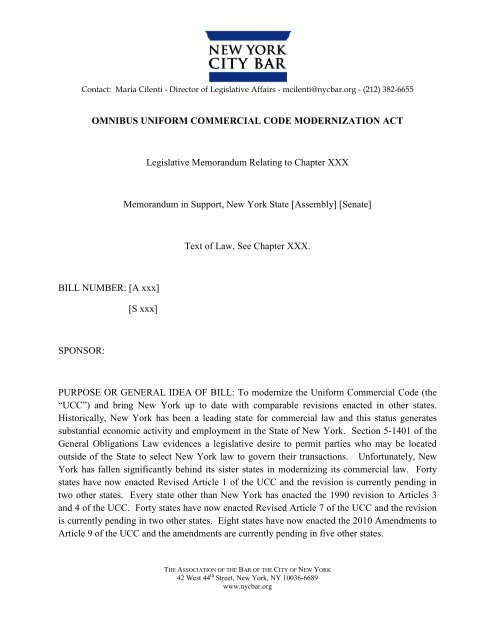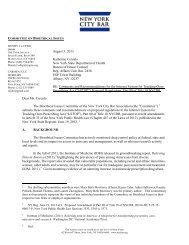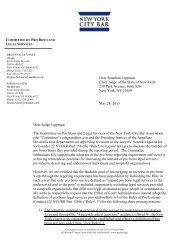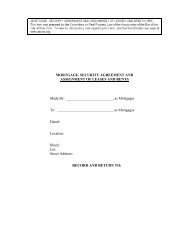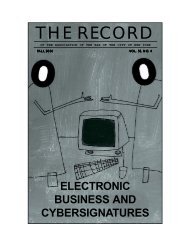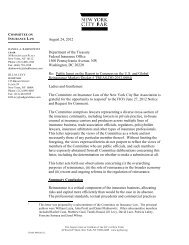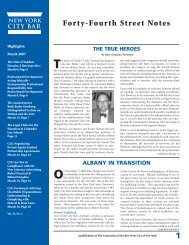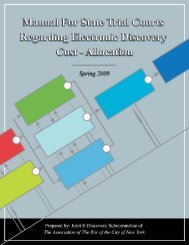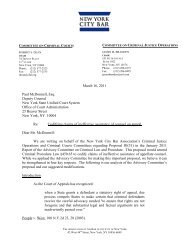OMNIBUS UNIFORM COMMERCIAL CODE MODERNIZATION ACT ...
OMNIBUS UNIFORM COMMERCIAL CODE MODERNIZATION ACT ...
OMNIBUS UNIFORM COMMERCIAL CODE MODERNIZATION ACT ...
You also want an ePaper? Increase the reach of your titles
YUMPU automatically turns print PDFs into web optimized ePapers that Google loves.
Contact: Maria Cilenti - Director of Legislative Affairs - mcilenti@nycbar.org - (212) 382-6655<strong>OMNIBUS</strong> <strong>UNIFORM</strong> <strong>COMMERCIAL</strong> <strong>CODE</strong> <strong>MODERNIZATION</strong> <strong>ACT</strong>Legislative Memorandum Relating to Chapter XXXMemorandum in Support, New York State [Assembly] [Senate]Text of Law, See Chapter XXX.BILL NUMBER: [A xxx][S xxx]SPONSOR:PURPOSE OR GENERAL IDEA OF BILL: To modernize the Uniform Commercial Code (the“UCC”) and bring New York up to date with comparable revisions enacted in other states.Historically, New York has been a leading state for commercial law and this status generatessubstantial economic activity and employment in the State of New York. Section 5-1401 of theGeneral Obligations Law evidences a legislative desire to permit parties who may be locatedoutside of the State to select New York law to govern their transactions. Unfortunately, NewYork has fallen significantly behind its sister states in modernizing its commercial law. Fortystates have now enacted Revised Article 1 of the UCC and the revision is currently pending intwo other states. Every state other than New York has enacted the 1990 revision to Articles 3and 4 of the UCC. Forty states have now enacted Revised Article 7 of the UCC and the revisionis currently pending in two other states. Eight states have now enacted the 2010 Amendments toArticle 9 of the UCC and the amendments are currently pending in five other states.THE ASSOCIATION OF THE BAR OF THE CITY OF NEW YORK42 West 44 th Street, New York, NY 10036-6689www.nycbar.org
ARTICLE 1SUMMARY OF SPECIFIC PROVISIONS: Other articles of the UCC have been revised andamended to accommodate changing business practices and developments in the law, and thesechanges need to be reflected in an updated Article 1. Revised Article 1 contains many changesof a technical, non-substantive nature, such as reordering and renumbering sections and addinggender-neutral terminology. In addition, revised Article 1 contains several changes to addgreater clarity with regard to provisions of Article 1 that have been identified as confusing orimprecise. Finally, revised Article 1 contains certain substantive changes where developments inthe law have led to the conclusion that substantive change was needed, such as: (1) revisedsection 1-102 clarifies the scope of Article 1 by expressly stating that the substantive rules ofArticle 1 apply only to transactions within the scope of other articles of the UCC; (2) revisedsection 1-103 clarifies the application of supplemental principles of law with clearer distinctionsas to when the UCC is preemptive; (3) the statute of frauds requirement aimed at transactionsbeyond the coverage of the UCC has been deleted; and (4) under revised Article 1, evidence of“course of performance” may be used along with course of dealing and usage of trade to interpreta contract.JUSTIFICATION: Article 1 impacts every transaction governed by the UCC, including any saleof goods, any transfer of a check or other negotiable instrument, any commercial electronic fundstransfer, any letter of credit, any warehouse receipt or bill of lading, any transfer of aninvestment security, and any credit transaction in which a security interest is taken in specificcollateral. These are the transactions governed by specific articles of the UCC and encompassthe bulk of commercial activity in the American economy. The rules and definitions of Article 1apply across these specific articles, binding these various articles together into one code.Because of this interrelationship, enactment of the articles discussed below without RevisedArticle 1 would require numerous spot amendments to those articles in order to “patch in” theappropriate Article 1 definition or rule.ARTICLES 3 AND 4SUMMARY OF SPECIFIC PROVISIONS: Article 3 governs negotiable instruments – checksand some notes. Article 4 governs bank deposits and collections, and establishes the legalframework for the customer’s dealings with its bank. Together these Articles comprise a unit thatgoverns instruments (and the debits and credits resulting therefrom) from the time they are issueduntil the time when final payment is made or the instrument is dishonored.Revised Article 3 treats additional types of instruments as “negotiable,” and therefore subject tothe Article 3 rules. Included in the new definition are notes with variable rates of interest (suchas variable rate mortgage notes), as well as checks that are not expressly made payable to order2
or to bearer. Because there are no legal rules covering non-negotiable instruments (except ascourts may apply Article 3 by analogy), the revisions provide clarification of the rules thatgovern such instruments.Likewise, Article 4 expands the definition of “bank” to include financial institutions other thancommercial banks.Many negotiable instruments are endorsed not by a writing on the back of the instrument, but bya writing on a separate piece of paper known as an “allonge.” The revisions clarify the status ofsuch writings, permitting them to qualify as endorsements even if not pasted or stapled to theinstrument and even if there is ample space on the instrument itself for an endorsement.The revisions eliminate wasteful circular litigation in instances in which a check is stolen and thepayee endorsement is forged. They clarify that the intended payee, having never received thecheck, retains its right to be paid by the drawer, although it cannot sue for conversion. Thedrawer retains its right to be recredited by its bank for unauthorized payment of the check,although it likewise cannot sue for conversion. The drawer’s bank recovers against the bank thatdealt with the thief, thus, the loss falls on the bank that was best able to prevent it.The revisions expressly state that a cashier’s check and a teller’s check are within the definitionof “check,” and provide some new rules to protect payees of such checks from the bank’sunjustified refusal to pay such instruments at the behest of a customer who originally instructedthe bank to issue the instrument, but has now decided to abort the payment. The revised rulesdiscourage dishonor by making the bank liable for the damages caused to the payee, including, ifadvance notice has been given, the payee’s consequential damages.New York law on accord and satisfaction – the practice of endorsing a check in payment of adisputed amount with the words “in full satisfaction” – is altered by the revisions. The revisionspermit a debtor to discharge its debt by making a payment that conspicuously states that it is infull satisfaction of the debt, but offers protection to an organizational creditor by enabling it toavoid inadvertent discharge by notifying its debtors to send payment of such disputed amounts toa specific location other than the location at which payments are normally received. (A nonorganizationalcreditor that inadvertently cashes such a check can reverse the discharge byreturning the funds to the debtor.)Automated processing is recognized in a number of places in the amendments. First, becausemost checks are not manually inspected, it is the customer’s obligation, upon issuing a postdatedcheck, to inform its bank of that fact so that it is not inadvertently paid. Likewise, a customer thatwishes to stop its check must describe the item with reasonable certainty so that the check can beflagged electronically.3
Current Article 4 establishes the time when a stop order, legal process, or other instruction isreceived too late to affect payment of an instrument as the moment the check is “posted,” a termthat contemplates a manual clerical process that is inconsistent with electronic processing. Therevisions permit a bank to arbitrarily establish the cut-off time and date, within prescribedparameters.The revisions provide for electronic presentment of checks and for retention of check imageswhen checks are truncated. The rules governing electronic collection of checks and fundsavailability, however, have increasingly been federalized, largely as a result of New York’s longstandingfailure to enact the revisions.Finally, the revisions establish a comparative negligence standard in an instance in which boththe bank and its customer were negligent with respect to a loss arising from an unauthorizedsignature or alteration of a check. Although this standard may have been novel when therevisions were first drafted, it is substantially identical to the Federal Reserve’s Regulation CC(governing check collection), which currently provides that: “(c) Comparative negligence. If aperson, including a bank, fails to exercise ordinary care or act in good faith under this subpartin indorsing a check (§ 229.35), accepting a returned check or notice of nonpayment (§§229.32(a) and 229.33(c)), or otherwise, the damages incurred by that person under § 229.38(a)shall be diminished in proportion to the amount of negligence or bad faith attributable to thatperson”(12 C.F.R. 229.38(c)).JUSTIFICATION: When the current versions of Articles 3 and 4 were enacted, in 1962,payments were paper-based, check processing was in its infancy, and banks were limited in theirability to branch within New York, much less nationally. Today these transactions are electronic,processing may be virtually instantaneous, and banks operate across state and national lines. YetNew York currently remains governed by an antiquated set of commercial laws that isincreasingly no longer taught to law students, even within New York. These laws present a trapfor the unwary advisor, who is likely to consult the uniform version of these Articles, notrealizing that New York is the only state that has failed to enact even the 1990 amendments.Additionally, they present troublesome choice of law problems for practitioners when part of atransaction takes place in a “new statute” jurisdiction, and part in New York, resulting in a lackof predictability as to outcome.The result of the failure to enact the revisions has been to render New York law increasinglyirrelevant, as parties to banking transactions have sought to elect the law of another jurisdiction,whenever possible, and to resolve risk allocation issues governed by these Articles by contract orsystem rule. Additionally, federal agencies are now addressing by regulation payment issues thatfall within the scope of Article 4, on the assumption that New York will not enact such revisionsif they become part of the Uniform Commercial Code. Enactment of the revisions cannot erasethe damage done, but will prevent the further erosion of New York’s payments law.4
ARTICLE 7SUMMARY OF SPECIFIC PROVISIONS: Article 7 governs “documents of title” – items suchas bills of lading and warehouse receipts that control the right to the goods described thereinduring commercial storage and shipment. When goods are imported, they are frequently paid forby means of a letter of credit (issued pursuant to Article 5 of the Uniform Commercial Code)calling for payment against specific documents of title, as described in Article 7. Thus, althoughdocuments of title may appear to be obscure instruments, they are in fact utilized on a daily basisby New York businesses and residents importing goods into the State.New York’s current Article 7 does not recognize electronic documents of title, and thereforedoes not permit goods covered by electronic documents to be transferred or financed. RevisedArticle 7 recognizes electronic documents of title, and establishes rules for the transfer of rightsembodied therein from one person to another. Control of an electronic document of title is theequivalent of possession and indorsement of a tangible document of title. Revised Article 7permits the conversion of electronic documents to tangible documents and vice versa. Inaddition, revised Article 7 extends statute of frauds requirements to include electronic recordsand signatures by creating new definitions of “record” and “sign”. The new definitions recognizeinformation stored in electronic format and electronic symbols, respectively, as the term“writing” is replaced with the term “record” wherever used in the Article.JUSTIFICATION: The revisions to Article 7 are consistent with the increasing recognition ofelectronic documents and instruments as equal in status to their paper counterparts under bothNew York and federal law.ARTICLE 9SUMMARY OF SPECIFIC PROVISIONS: Article 9 governs security interest in personalproperty. The Article was substantially revised and enacted in New York in 2001. The currentbill contains targeted amendments (the “Amendments”) to Article 9 relating to the rules for thesystem for filing and searching financing statements, other discrete changes and some transitionrules.I. Changes Relating to the Filing RulesThe Amendments contain a number of changes related to the rules for the filing system.5
IndividualA. Name to be Provided on a Financing Statement When the Debtor is anThe most important change effected by the Article 9 revisions is that they establish thename to use when filing a UCC financing statement against a debtor who is an individual.Presently, there is no law that establishes the “legal name” of an individual. Many officialdocuments issued to the same person – birth certificate, passport, and driver’s license –frequently appear with different names, or variations of names. None of these may correspondwith the name actually used by that person for business transactions. Foreign namingconventions further complicate matters, as the person’s family name, rather than the given name,may appear first. Yet it is the responsibility of the secured party making a UCC financingstatement filing to establish the correct legal name of the individual, at the risk of making a filingthat is legally ineffective.To provide greater guidance, any of the following names for an individual debtor wouldbe sufficient as the debtor’s name on the financing statement: (1) the debtor’s name as shown onthe debtor’s driver’s license if the debtor holds an unexpired driver’s license issued by the statewhose law governs perfection under Article 9’s conflict of laws rules, (2) the individual name ofthe debtor, as under current Article 9, or (3) the debtor’s surname and first personal name. If thedebtor holds two driver’s licenses issued by the state, the most recently issued driver’s license isthe one to which reference should be made to determine the debtor’s name to be provided on thefinancing statement.B. Definition of “Registered Organization”The Amendments modify the definition of “registered organization” to reflect that anorganization is a registered organization if it is formed or organized solely under the law of asingle state by the filing of a public record with the state rather than, as under current Article 9,by the state merely being required to maintain a public record showing that the organization hasbeen organized. This change will more accurately reflect that a registered organization includesan organization whose “birth certificate” emanates from the act of making a public filing.Furthermore, the Amendments expand the definition of “registered organization” toinclude a common law trust that is formed for a business or commercial purpose and is requiredby a state’s business trust statute to file with the state an organic record, such as the trustagreement for a common law trust. This change will mean that a Massachusetts business trust,for example, will be considered to be a registered organization rather than, as would appear to bethe case under current Article 9, an organization that is not a registered organization.6
C. Name of Registered OrganizationThe Amendments clarify that, for a financing statement to be sufficient, the name of theregistered organization debtor to be provided on the financing statement is the name reflected onthe “public organic record” of the registered organization. In most cases, a registeredorganization’s “public organic record” is the publicly available record filed with the state to formor organize the registered organization.D. Name of Debtor When Collateral is Held in TrustThe Amendments require that, when the collateral is held in a trust that is not a registeredorganization, the filer must provide in a separate part of the financing statement a statement thatthe collateral is held in trust. The reference to “collateral held in trust” replaces the referenceunder current Article 9 to the debtor being the trust or the trustee. The reference to the debtorbeing a trust or trustee was thought to be confusing in practice especially because typically undera common law trust in most states the debtor would be the trustee.If the name of the settlor or testator is provided as the debtor’s name, the filer mustprovide in a separate part of the financing statement sufficient information to distinguish the trustfrom other trusts of the same settlor or testator. That distinguishing information often could be,for example, merely the date of the trust agreement.The requirement that this information be inserted in a separate part of the financingstatement was intended to reduce the risk that a secured party would provide the information inthe debtor’s name block of the financing statement. Under the search logic of the filing office insome states, additional information provided in the debtor’s name block may cause the financingstatement to be ineffective if a search of the debtor’s name without the additional informationwould fail to disclose the financing statement.E. Name of Debtor When Collateral is Administered by a PersonalRepresentativeCurrent Article 9 refers to the possibility that the debtor may be an estate. Theamendments more accurately refer to collateral that is being administered by a personalrepresentative of a deceased debtor. In such a case the name of the deceased debtor on thefinancing statement will be sufficient as a “safe harbor” if the name provided is the name of thedebtor on the court order appointing the personal representative. If the appointment ordercontains more than one name for the debtor, the first name of the debtor on the appointmentorder is sufficient.7
F. Debtor’s Change of LocationUnder current Article 9, if a debtor changes its location to a new jurisdiction, a securedparty whose security interest was perfected by filing in the original jurisdiction has a period of upto four months to continue the perfection of its security interest by filing a financing statementin, or otherwise perfecting the security interest under the law of, the new jurisdiction. The fourmonth grace period applies, however, only to collateral in which the secured party’s securityinterest was perfected at time of the change of location. Of course, a security interest in propertyacquired by the debtor after the time of the change of location will not be perfected at the time ofthe change because the security interest in the after-acquired property will not attach until theproperty is acquired by the debtor and the debtor then has rights in the collateral. There is nograce period under current Article 9 for perfection of any security interest that may attach topost-change of location after-acquired property of the debtor.The amendments add a grace period for the after-acquired property. They do so byproviding that the financing statement filed in the original jurisdiction is effective with respect tocollateral acquired within the four months after the debtor’s location changes. The secured partycan continue perfection beyond the four-month period by filing a financing statement orotherwise perfecting under the law of the new jurisdiction.The amendments will provide greater protection for a secured party with a securityinterest in after-acquired property of its debtor if the debtor changes its location.G. New DebtorThe Amendments provide similar protection for a security interest in after-acquiredproperty if a new debtor becomes bound by the original debtor’s security agreement and the newdebtor is located in a different jurisdiction from the jurisdiction in which the original debtor waslocated. For example, if Old Debtor located in State A merges into New Debtor located in StateB, under current Article 9 there is a grace period of up to one year for the secured party of OldDebtor to file a financing statement against New Debtor in State B to continue the effectivenessof the financing statement that the secured party filed in State A against Old Debtor. But thegrace period applies only to a security interest that was perfected by filing in State A at the timeof the merger. There is no grace period for perfection of any security interest that may attach topost-merger after-acquired property. Using an approach similar to that taken with respect toproperty acquired by a debtor after it relocates, the Amendments provide for a grace period of upto four months in the case of such an interstate merger.As under current Article 9, a security interest in post-merger after-acquired property thatis perfected solely by the financing statement filed by the secured party against Old Debtor inState A will be subordinate to a security interest of a competing secured party perfected by thefiling of a financing statement against New Debtor in State B. This result for an interstate8
merger is consistent with the treatment of after-acquired property of a new debtor in the case ofan intrastate merger.H. Other Filing Related ChangesThe Amendments provide for other changes to the filing rules in Part 5 of Article 9:• Only an initial financing statement may indicate that the debtor is a transmitting utility, inwhich case the financing statement does not lapse. Current Article 9 suggests that an initialfinancing statement may be amended to indicate that the debtor is a transmitting utility. Thestatutory change will make the transmitting utility filing provision consistent with the publicfinanceand manufactured-home transactions filing provision.• A filing office will no longer be permitted to reject a financing statement that fails toprovide the type of organization of the debtor, the jurisdiction of organization of the debtor, orthe organizational identification number of the debtor or a statement that the debtor has none.This information was not considered to be sufficiently useful in practice and often added costand delay to the filing process.• The term “correction statement” as used in current Article 9 has been changed to themore accurate “information statement.” Under the Amendments, an information statement may,but need not, be filed by a secured party of record who believes that an amendment or otherrecord relating to the financing statement of the secured party of record was filed by a person notentitled to do so. Under current Article 9 a correction statement may be filed only by the debtor.• The uniform forms of initial financing statement and amendment have been updated toreflect the Amendments.II.Changes Unrelated to FilingThe Amendments contain some changes that are less connected to the filing rules in Part5 of Article 9.• Current section 9-406 renders unenforceable an anti-assignment term of a paymentintangible or promissory note that secures an obligation. By way of contrast, current section 9-408 permits a sale of a payment intangible or promissory note notwithstanding an antiassignmentterm but does not require the account debtor or maker to attorn to or otherwiserecognize the buyer. The Amendments clarify that effectiveness of an anti-assignment term of apayment intangible or promissory note in the case of a sale or other disposition of collateralunder section 9-610 or an acceptance of collateral under section 9-620 is governed by section 9-406 and not by section 9-408.9
• The Amendments modify the definition of the term “authenticate” to conform to thedefinitions of “sign” in the revisions contained in the bill to Article 1 and Article 7.• The Amendments modify the definition of “certificate of title” to take into account statecertificate of title systems that permit or require electronic records as an alternative to theissuance of certificates of title.• The Amendments modify the requirements for control of electronic chattel paper toconform them with those in revisions contained in the bill for Article 7 for electronic documentsof title and in the Uniform Electronic Transactions Act for transferable records. The result is thatthe new requirements set forth the current requirements as a “safe harbor” but permit othercontrol systems as well.• The Amendments clarify that a registered organization organized under federal law, suchas a national bank, that, by authorization under federal law, designates its main or home office asits location is located in the state of that office for purposes of Article 9.• The Amendments expand the list of collateral for which a licensee or buyer takes free ofa security interest if the licensee or buyer gives value without knowledge of the security interestsand before it is perfected.• The Amendments confirm that a secured party’s authorization to record an assignment ofa mortgage securing a promissory note assigned to the secured party in order for the securedparty to conduct a non-judicial foreclosure sale of the mortgaged real property applies whenthere is a default by the mortgagor. The language in current Article 9 could arguably have beenread to refer to a default by the assignor of the promissory note rather than by the mortgagor.• The NY Amendments contain non-uniform provisions modeled on the Delaware UCCthat are intended to clarify when a secured party has “control” over deposit accounts andsecurities accounts.JUSTIFICATION: The Amendments provide greater certainty for the sufficiency of the name ofa debtor on a financing statement by tying the concept of “legal name” to “license name.” By sodoing, the revisions may help to reduce the current practice of requiring debtors who areindividuals to incorporate or establish limited liability companies (whose legal name is easilydetermined) to qualify for continuing commercial credit. In addition, the Amendments address anumber of filing system concerns under current Article 9 raised by International Association ofCommercial Administrators, and resolve ambiguities and address technical issues discovered incurrent Article 9 where there were substantial problems in practice or as to which some stateshave enacted non-uniform amendments.10
PRIOR LEGISLATIVE HISTORY: This bill has not been previously introduced.FISCAL IMPLICATIONS: New York is under increasing competition to maintain its rank as aleading commercial jurisdiction. Today, significant commercial transactions may be domiciled ina U.S. jurisdiction that has modernized its law, or in a foreign locale that has a mature legalsystem. While sophisticated and complex commercial transactions are not themselves taxed, theygenerate both jobs and income for New Yorkers, particularly in the financial services sector. Ithas been estimated that for each professional job that is lost, there are at least one to twoadditional nonprofessional jobs that are lost as well. Keeping New York’s commercial law asmodern as any in the nation will help maintain its status as a preeminent commercial jurisdiction.EFFECTIVE DATE: This Act shall take effect on the day it shall become a law, except that therevisions to Article 9 shall take effect on July 1, 2013.11


